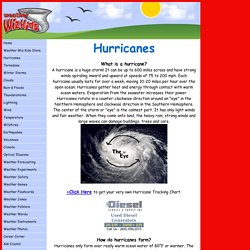

5 Years After Katrina, Ruins—And a Natural Wonder—Remain. How Hurricane Katrina Formed. Animated guide: Hurricanes. Introduction to winds. Introduction to winds Hold your palm over your nose, and breathe out hard — you must have felt something from your nose pressing against your palm, yes?

You did not see it, but you clearly felt it. That was air you felt. Now, if you have seen a vacuum cleaner work, you will notice how it sucks all the little debris, pieces of rubbish and dust in its’ path. Again, that was air being sucked together with all the little stuff. Both scenarios have something to do with air being directed at or pulled from something.
The earth is surrounded by the atmosphere (a blanket of gases). Air, like other liquids and gases are fluids. Now we shall see how air and wind relate, and how winds behave in many different places and conditions around the earth. Weather Wiz Kids weather information for kids. Who are the "Hurricane Hunters"?

The brave "hurricane hunters" work for the National Oceanic and Atmospheric Administration (NOAA). Each mission lasts about ten hours, with the crews passing four to six times through the storm. The planes carry radar, sophisticated computers, and weather instruments that determine characteristics such as temperature, air pressure, wind speed, and wind direction inside the hurricane. The crews also release instruments that measure temperature, air pressure, and wind at different levels as the devices drop through the hurricane toward the ocean. By mission's end, NOAA can warn everyone in the hurricane's path.
Tropical Tracks: Click to see the tracks of this year's storms. Past Hurricane Info: Click to find all the data and information about a specific hurricane by just knowing the year. Know the Lingo TROPICAL STORM WATCH - Tropical Storm conditions with sustained winds from 39 -74 mph are possible in your area within the next 36 hours. Hurricane Stages. Information on Hurricanes and Tropical Storms for young people. Hurricanes and Tropical Storms Introduction A Hurricane, like other natural disasters, is one that we all pause to listen to each time we hear of it on the news.

This is because we have all seen the devastation that it can bring to us. Many people have experienced it in one way or the other, and we have come to appreciate that hurricanes are not things that we can do much about in terms of its occurrence. It is natural. However, with modern monitoring systems and technology, we can be warned of impending hurricanes and take some reasonable level of caution to minimize the damage and the effect it can have on us. Hurricanes are also called Typhoons or Cyclones in other parts of the world.
FAQ HURRICANES, TYPHOONS, AND TROPICAL CYCLONES. Back to Main FAQ Page version 4.7June 1, 2014 L : HURRICANES versus TORNADOES Introduction This FAQ (Frequently Asked Questions) web site attempts to address various questions regarding hurricanes, typhoons and tropical cyclones that have been posed to us as hurricane researchers over the years.

While it is not intended to be a technical guide, references are given throughout the FAQ for those that would like additional, detailed information. Also, there is no guarantee that all that is in here is completely accurate (we're human!). Hopefully, this FAQ site can help answer some of the questions that you may have about the characteristics of these catastrophic storms, how they are monitored and forecasted, and what are some of research topics that are being addressed today. We'd like to thank various people for helping to put together this FAQ: Sim Aberson, Jack Beven, Gary Padgett, Tom Berg, Julian Heming, Gary Gray, Frank Woodcock, Stephen Caparotta, Steven Young, D. Chris Landsea (NHC)